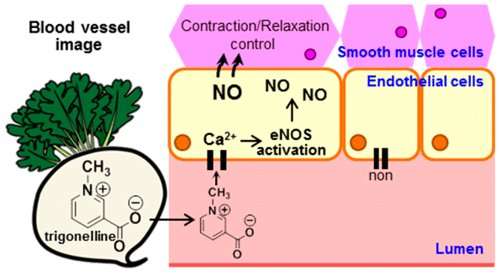Compounds in 'monster' radish could help tame cardiovascular disease

Step aside carrots, onions and broccoli. The newest heart-healthy vegetable could be a gigantic, record-setting radish. In a study appearing in ACS' Journal of Agricultural and Food Chemistry, scientists report that compounds found in the Sakurajima Daikon, or "monster," radish could help protect coronary blood vessels and potentially prevent heart disease and stroke. The finding could lead to the discovery of similar substances in other vegetables and perhaps lead to new drug treatments.
Grown for centuries in Japan, the Sakurajima Daikon is one of the Earth's most massive vegetables. In 2003, the Guinness Book of World Records certified a Sakurajima weighing nearly 69 pounds as the world's heaviest radish. Radishes are good sources of antioxidants and reportedly can reduce high blood pressure and the threat of clots, a pair of risk factors for heart attack and stroke. But to date, no studies have directly compared the heart-health benefits of the Sakurajima Daikon to other radishes. To address this knowledge gap, Katsuko Kajiya and colleagues sought to find out what effects this radish would have on nitric oxide production, a key regulator of coronary blood vessel function, and to determine its underlying mechanisms.
The researchers exposed human and pig vascular endothelial cells to extracts from Sakurajima Daikon and smaller radishes. Using fluorescence microscopy and other analytical techniques, the research team found the Sakurajima Daikon radish induced more nitric oxide production in these vascular cells than a smaller Japanese radish. They also identified trigonelline, a plant hormone, as the active component in Sakurajima Daikon that appears to promote a cascade of changes in coronary blood vessels resulting improved nitric oxide production.
More information: Rei Kuroda et al. Elucidating the Improvement in Vascular Endothelial Function from Sakurajima Daikon and Its Mechanism of Action: A Comparative Study with Raphanus sativus, Journal of Agricultural and Food Chemistry (2018). DOI: 10.1021/acs.jafc.8b01750
Abstract
Vascular diseases, such as myocardial and cerebral infarctions, are the leading causes of death. Some vascular diseases occur as the result of decreases in vascular endothelial function. The innermost layer of the vasculature is formed by vascular endothelial cells (VECs), which are critical for nitric oxide (NO) synthesis. In our search for active constituents in farm products with the potential for improving the vascular system, we examined the effect of Raphanus sativus cv. Sakurajima Daikon on NO production in VECs. In this study, we found that the underlying mechanism for stimulating NO production by Sakurajima Daikon extract involves endothelial-NO-synthase (eNOS) activation by the phosphorylation of Ser1177 and the dephosphorylation of Thr495, which are triggered by elevated concentrations of cytoplasmic Ca2+ resulting from the activation of Ca2+ channels in VECs. We observed that trigonelline, an active constituent of Sakurajima Daikon, improves NO production in VEC cultures.
Journal information: Journal of Agricultural and Food Chemistry
Provided by American Chemical Society




















